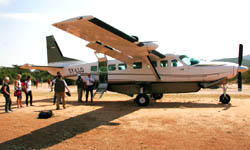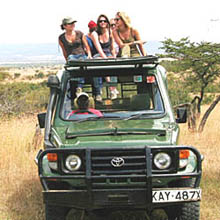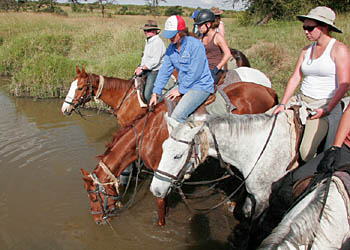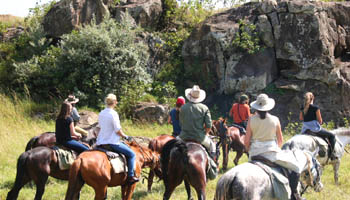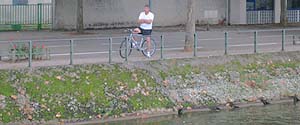The 'Rio + 20 Conference' was held 20 years after the productive '1992 UN Conference on Environment and Development', known as the 'Earth Summit,' that brought together world leaders (including US President George H.W. Bush) to hammer out several major international agreements.
The Earth Summit produced the Rio Declaration on Environment and Development; Agenda 21 (a 900 page list of suggestions on how to promote sustainable development, conserve resources and reduce costs); Forest Principles; the Convention on Biological Diversity and the Framework Convention on Climate Change.
A few logistical challenges plagued the 2012 Rio Conference before it ever began. For example, the dates had to be changed because the original ones conflicted with Queen Elizabeth's Diamond Jubilee; Rio hotels reportedly had only 33,000 beds for an anticipated influx of 50,000 visitors that led to severe price gouging and skyrocketing room rates, ultimately causing several delegations to cancel their plans to attend, and the city was plagued with traffic jams.
Regardless, these were minor nuisances that confronted the governmental, private sector and civil society attendees who were often at loggerheads with one another on how to deal with what may be the greatest challenge to planet Earth and all living species: climate change. Figuratively speaking, mountains of scientific data and reports conclusively show that the weather patterns are changing, glaciers are melting, seas are rising, desertification is occurring and heat waves, forest fires, floods and storms are becoming more frequent and severe. Just in the US, nearly 4,000 daily high temperature records were set for the month of June in 2012.
The 'Rio + 20 Conference' has been categorized by such descriptive terms as “a political charade,” and a 'failure of epic proportions.' UN Secretary General (SG) Ban Ki-moon first described it as 'modest... a firm foundation,' and then later as a 'success.' It may be a partial combination of all of these observations since there were both achievements and setbacks.
After contentious wrangling, world leaders did approve the outcome document for Rio+20 entitled “The Future We Want,' which was agreed to by the Member States of the United Nations.
Perhaps the most important achievement at the conference was that more than $500 billion, with over 700 commitments, was made to take action on sustainable development initiatives. These commitments addressed a myriad of global issues that include access to clean energy, food security, water and sustainable transportation.
The document also calls for a vast range of actions, including countries to re-commit themselves to sustainable development, establishing a set of sustainable development goals (SDGs) and launching a high-level political forum on sustainable development.
Additionally the document emphasized how the green economy can be used as a tool to achieve sustainable development, strengthen the UN Environment Program and promote corporate sustainability reporting measures.
Regarding corporations, the business community is a prime economic generator and contributes to a large part of the climate change problem, thus should be part of the solution. One major meeting prior to the Rio Conference was a Forum, organized by the UN Global Compact and others, that brought together 2,700 business leaders, investors, academics, government officials, environmentalists and grassroots activists.
The Forum issued the 'Rio+20: Final Business Forum Text' that included a commitment by business leaders to help create and implement new Sustainable Development Goals. CEOs from 45 major corporations suggested how governments can better manage water supplies and how businesses can use and restore natural resources more efficiently. Nearly 300 institutions of higher education signed on to placing sustainable development as a major part of college and university curricula.
The United Nations Global Compact (www.unglobalcompact.org), the largest voluntary association of over 7,000 business in 135 countries, is committed to ten universally accepted principles in the areas of human rights, labor, environment and anti-corruption.
Another suggestion from the Rio Conference was that nations need to re-define the concept of Gross Domestic Product (GDP) to assess the well-being of a country. Rather than solely use the economic benefit of GDP, emphasis should be upon a macro approach to view the health and viability of natural resources, such as forests, oceans and rivers, as well as the hidden social and environmental costs associated with consuming fossil fuels--especially major pollutants such as coal and petroleum. This ties into the concept of adopting a framework for tackling sustainable consumption and production and making the 'polluter' pay for the damage.
Another approach is to eliminate the $750 billion subsidies governments dole out each year to promote the use of fossil fuels. Although alternative clean energy sources are still rather expensive and not commercially competitive in some areas, subsidizing clean energy sources would make them more competitive. Some significant projects include Germany moving from nuclear power to renewable sources of energy. In Southern California, the cost per kilowatt hour of solar energy is reportedly equivalent to that of current electricity. When an alternative, such as solar, is economically viable -- and it may be in the not-too-distant future -- the term 'coal mine' will be about as obsolete as the 'iron lung' is to a discussion of polio today.
A major recommendation of the Rio Conference was to empower women economically, socially and politically. Secretary of State Hillary Clinton, who represented the Obama Administration in Rio, expressed approval of the final document's endorsement of women's sexual and reproductive health; however, she expressed her dismay and concern with the deletion of references to reproductive rights, which is construed by pro-life proponents as a euphemism for abortion. Observers contend that the 'pro-life' conservative groups, led by the Vatican which has Observer Status at the UN, deleted the reference.
A critical path to empower women is to provide educational opportunities, the ability to determine their family size and to have access to reproductive health choices.
What were some other major trends or lessons learned from the conference?
1) It may be unrealistic to expect that a Grand Bargain will be adopted by 193 governments. Some of the governments have vested interests in fossil fuel industries and receive benefits in the form of jobs, economic investments, financial assistance for charities and other institutions, as well as campaign contributions to politicians who then develop laws and regulations that favor those industries. Although governments play a key role, the Rio Conference demonstrated that other players, e.g. nongovernmental organizations, academia and businesses, were decentralizing the process and making more commitments, in many cases without governmental support.
2) On the other hand, many governments are taking bold action to confront climate change. For instance, Germany, hardly known for its sunny weather, apparently receives over 40 % of its electricity from solar units. Denmark gets 20% of its electricity from wind. Australia has put a price on carbon, and California is launching a comprehensive cap-and-trade system to reduce greenhouse gas emissions. A US federal appeals court, for the first time ever, upheld regulations to reduce gases that are often linked with global warming. Given the climate change-denial mentality of the US Congress, legislation of this type would be impossible to pass through normal legislative processes.
The Yasuni-ITT Initiative is an Ecuadorian Government project to permanently protect the oil reserves in the pristine Yasuni National Park. Although Ecuador is a poor country and is an oil producer, it hopes to receive $3.6 billion over 13 years from the international community in exchange for not tapping 846 million barrels of oil, with the rationale to conserve biodiversity, protect indigenous peoples and reduce CO2 emissions.
The Virginia Legislature, denying both irrefutable scientific evidence and common-sense logic, is sending out conflicting, schizophrenic messages. The Legislature has appropriated state funds to study and to combat erosion of the Virginia coastal areas; while, at the same time, taking legislative action to ban using the terms 'climate change' and 'sea level rise,' which are key cause-and effect terms as to what is impacting the Atlantic Ocean. The journal 'Nature Climate Change' reported a study indicating a 600-mile 'hot spot' in the Atlantic Ocean causing sea levels to rise 3 to 4 times faster than the global average since 1990. Computer models estimate that sea levels globally could rise by 3.3 feet by 2100, or perhaps sooner.
3) Currently, the planet is straining under a population explosion. How much pressure will be on resources when, as the UN predicted, there will be 9-10 billion by 2050? Even at 7 billion people today, the strains indicate that the earth's finite resources are being consumed at a more rapid rate and an expanding population puts additional pressure on the ecosystem.
A recent example of environmental pressures and human improvement was driven home in an article in the New York Times on the proliferation of window air conditioners in the slums of Mumbai, India. As the residents' income increased so did their aspirations to improve their quality of life and to enjoy various amenities. The air conditioners are using an environmentally friendly coolant but are still belching out a warming effect of 2,100 times that of carbon dioxide. Most people, which is to be expected, want to improve their standard of living by acquiring better food, refrigerators, autos, and other necessities when their incomes rise.
4) The climate change discussion -- even with its shortcomings -- would not have reached this point had it not been for actions by the United Nations, such as establishing the international scientific Intergovernmental Panel on Climate Change in 1988, bringing key players together at various UN conferences on climate change and utilizing UN agencies to combat this problem. The UN's main strength is to provide a forum or structure within which climate change can be discussed and acted upon. Perhaps the most important ingredient in this recipe was the Herculean effort of UN SG Ban Ki-moon who -over six years ago-identified climate change as one of the major challenges and encouraged governments and others to be involved in confronting the problem. The SG's 'Good Offices' elevated the topic and shone the spotlight on a problem that affects all living beings.
5) Climate change deniers may be diminishing. Over 96% of climate scientists believe that climate change is occurring, yet there is some minor professional disagreement as to how damaging the phenomenon may be. One group that has consistently been in the 'climate change -denier camp' are meteorologists, of which about 20% believe climate change is factual. That may be changing. Paul Douglas, a self-described free-market Republican, practicing Christian and professional meteorologist in a Bloomberg Businessweek article, indicated he no longer believed climate change is a hoax, given the overwhelming evidence that the last decade was the warmest on record and included nine of the 10 hottest years. Other areas of concern are the 71% drop in the Great Lakes peak ice since 1973, winters are shorter, animals and plants are moving northward and humans pump out 30 billion tons of carbon dioxide each year.
Another potential convert is Rex Tillerson, Exxon's Chief Executive, who did a 180 degree flip and professed that carbon dioxide emissions from fossil fuels are warming the planet. Mr. Tillerson, who erroneously suggested that climate change is 'manageable,' heads a company that has been a major contributor to faux-science think tanks and pseudo scientists that have fought climate change reports and have disseminated disinformation and misinformation to cultivate doubts about the science.
6) The climate change discussion directly ties into the UN Millennium Development Goals (MDGs), which were adopted in 2000 and come to fruition in 2015. The MDGs aim to halve abject poverty, provide universal primary school education, reduce maternal and child mortality rates, empower women, combat AIDS, promote sustainable development and develop cooperative international partnerships. Achieving the MDGs will depend on how successful the climate change battle is waged, and vice-versa.
Former First Lady Eleanor Roosevelt said, 'Learn from the mistakes of others. You can't live long enough to make them all yourself.' These are prophetic words for political leaders who are still making foolish mistakes by funneling subsidies to fossil fuel industries, by denying or downplaying overwhelming scientific evidence that global warming is occurring and by fighting rear guard actions to keep alive industries, such as coal, that are destroying the planet. Earth is near the 'tipping point,' which some scientists say is 2015 -- if we are to keep warming below 2 degrees. Political leaders, public administrators, businesses, environmentalists, media, along with every human being, need to focus like a laser beam on this problem. Given the Rio Conference agreement failed to stress the need for urgency, more substantive action is needed now, not tomorrow, to confront the world's number one major threat.
_____________
Bill Miller, former Chair of the UN Association of the USA's Council of Chapter and Division Presidents, is the accredited Washington International journalist covering the UN and is the Producer/Moderator of “Global Connections Television.”






















